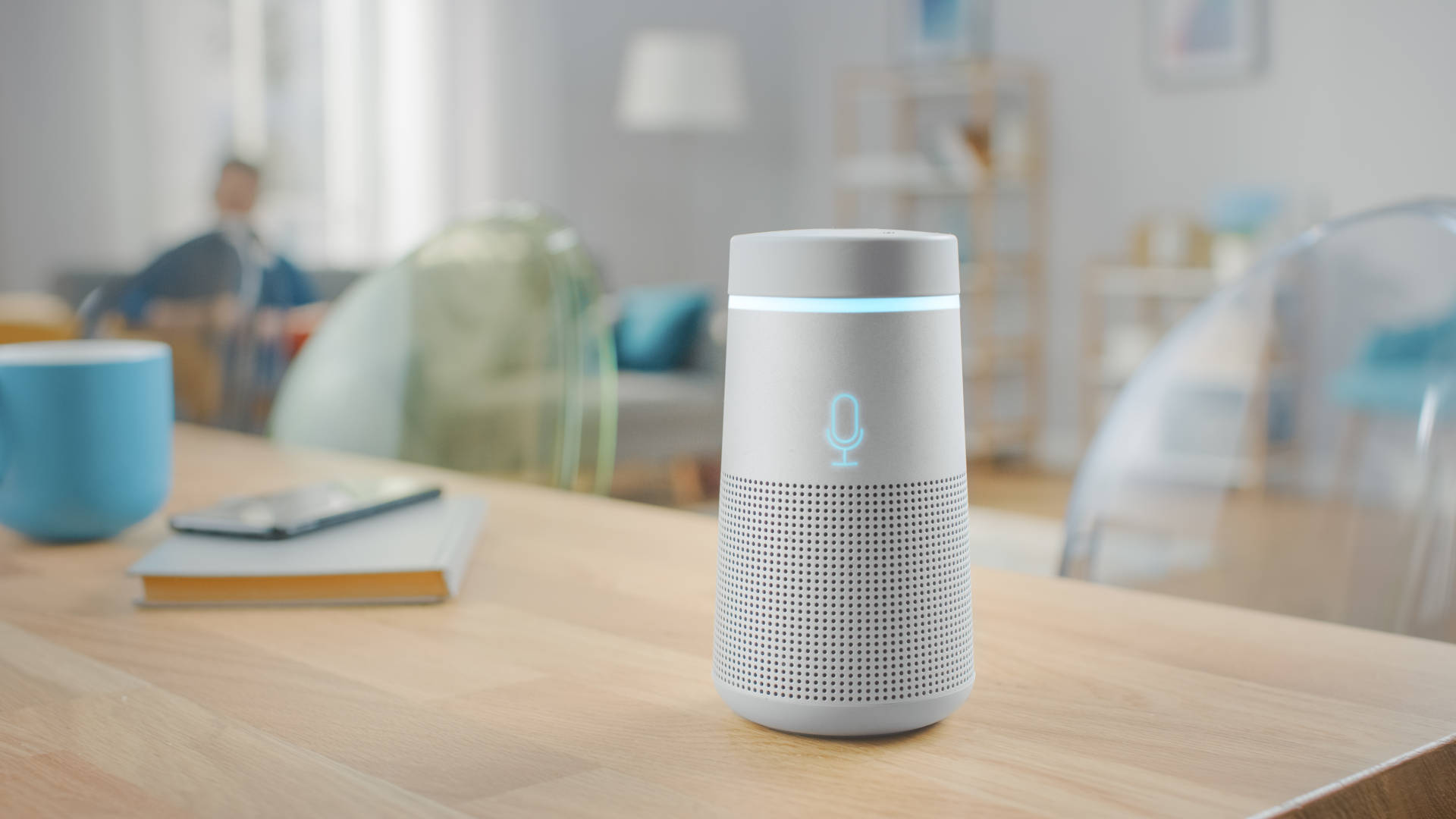The Future of Voice Assistants

April 25, 2022
By Pavel Jiřík in Blog
Do you have an Alexa speaker in your home or maybe you use Google’s Voice on your smartphone? The number of devices that use voice to communicate with their users just keeps on growing. Global smart speaker sales reached an all-time high of 150 million units in 2020. In addition, 34% of people who do not currently own a voice assistant are interested in purchasing one.
Over the past few years, the adoption of voice search has grown significantly as well. 65% of 25-49-year-olds speak to their voice-enabled devices at least once per day whether it’s to get answers to their questions, find local businesses, or make purchases. And since not only customers but also businesses are looking at voice search and voice assistants with growing interest, we can be sure that these devices are here to stay.
Why have voice search and voice assistants become so popular recently, though? What are they, how do they work, and where are they heading?
What Are Voice Search and Voice Assistants?
Voice search is pretty much what it sounds like - using your own voice (rather than a keyboard) to ask questions or give commands to your smartphone, wearable device, or smart speaker. You simply need to speak to the device and it will answer your question or execute the desired task.
Meanwhile, voice assistants are special programs that can recognize humans via speech recognition and natural language processing technologies, “translate” words into machine commands, then perform the desired tasks. They are also getting smarter with time - the more you interact with a voice assistant, the better it can understand your preferences and match its actions to your expectations.
Although using voice search was already fairly popular thanks to Siri and Alexa, the technology really took off once voice assistants became available on smartphones, tablets, and wearables. And as more people get comfortable talking into their phones or intelligent virtual assistants, the more this trend is set to catch on.
Just look - by 2024, the number of digital voice assistants is expected to reach 8.4 billion units, meaning there would actually be more voice assistants in the world than humans.
How Does a Voice Assistant Work in Practice?
How can a voice assistant understand what we are saying, though? Well, they are based on the ASR (Automatic Speech Recognition) system.
First, these systems record speech and then break it down into distinct sounds or groups of them (phonemes), which are translated into text. The assistant can also analyze and “remember” the tone, frequency, and hundreds of other aspects of a person's voice to know exactly who is speaking to it.
The voice assistant starts working once the user activates it with a “wake word.” Amazon Alexa users say that name to activate the voice assistant, while Apple users can say “Hey Siri” to do the same.
So, for example, you can ask Siri on your iPhone, “Siri, what’s the weather like today?”. Once the device wakes up and translates your question into a machine command, it will retrieve information from the Internet or an application to find the answer - in this case, pulling up an online weather forecast for that day.
However, it’s the use of artificial intelligence and, specifically, machine learning that has enabled voice assistants to get smarter with time. Thanks to these technologies, modern voice assistant apps no longer need to rely on a limited pre-installed vocabulary but instead can access millions of words and phrases in the cloud. Thanks to machine learning algorithms, voice assistants can also listen to a whole speech to understand the context rather than each word separately.
Which Voice Assistants Are Most Popular?
Modern voice assistants can do almost anything you might be able to think of. You can use them to play music, answer your questions, make phone calls, and even control parts of your home, such as the lights or thermostat. And they are so convenient to use too - whether you want to start the coffee machine or check the news, the assistant will report back to you in seconds.
72% of voice assistant owners admit that their devices quickly became an essential part of their daily routines and that they wouldn’t want to return to “regular” ways of controlling their appliances. What’s more, 55% of teenagers say that they use voice search every day.
It’s hard to believe voice assistants have only been with us since 2011, right? Since Apple introduced Siri and soon after that Google and Amazon introduced their own voice assistants, the capabilities and popularity of voice assistants and voice search have been growing steadily.
Alexa, for example, already has 100,000 skills available through which you can control your home devices, order pizza, play trivia games, listen to the news and weather, or shop online. Google meanwhile boasts that its assistant has more than one million actions available and supports over 100 languages.
As for Siri, around 500 million people use it on their phones. In fact, the latest voice search statistics indicate that almost 98% of iPhone owners have tried it at least once.
No wonder then that these three companies account for most of the voice assistant market. Amazon is the leading vendor in the global smart speaker market, holding a market share of 26.4% in the third quarter of 2021. Their closest competitor is Google, with a share of 20.5%. On the smartphone front, Siri leads with 45.1% of the market, followed by Google Assistant at 29.9%.
Impressive? Then take a look at this. Smart speakers and voice search statistics predict that global sales of smart speakers and voice-activated devices will surpass $30 billion by 2024. The US smart speaker market will play an important role in this, as projections are that 55% of American households will own a smart speaker by 2022.
What Can Voice Assistants Do?
Why do so many people use these devices, though? Simple - they are incredibly helpful.
For now, most of us use voice assistants for simple tasks like playing music, creating shopping lists, turning on and off various intelligent devices in our homes, learning about weather and traffic news, or ordering food. Is that all they can do?
No, it’s more like voice assistants are only just now starting to show us their full potential. From thermostats, fridges, ovens, and microwaves to vacuum cleaners, doorbells, and smart lamps - all of those home appliances can be controlled hands-free and at a distance just by using voice commands.
A second recent growing trend is the incorporation of voice assistants into business software. Those applications can keep working 24/7, whether it’s on information processing, data review, coordinating meetings, monitoring equipment, or keeping vital processes up-to-date. Various companies also use voice recognition technology to record notes from meetings or interviews as this is far faster than writing, and there is less risk of losing any critical information.
The use of voice technology in education is another interesting idea. Recently, universities have shown a keen interest in incorporating voice technology into education in order to help their students learn and perform better.
As an example, students often have to spend lots of time searching the internet for information about certain topics in order to resolve their doubts. On the other hand, a voice assistant can search the internet for them and provide accurate, relevant results quickly. The voice assistant would be even more useful if it had a special skill to assist students around the school or campus - for example, telling them about the teachers’ office hours or reminding them of due assignments.
Another useful option is to use voice assistants to help students catch up on material or revise for exams. Teachers can record their lectures and then upload them as podcasts. Then, students can download and listen to those recordings at any time simply by asking their voice assistant to play them.
These days, many cars also come with capable voice assistants already installed. The biggest benefit here? By allowing drivers to answer a call, read a message, or use Google Maps simply through voice commands, voice assistants are removing many of the distractions that might cause drivers to take their eyes off the road.
In fact, a recent report published by the UK’s Transport Research Laboratory (TRL) shows that driver distraction levels are much lower when using voice-activated systems compared to touch screens. However, the study recommends that further research is necessary to drive home the use of spoken instructions as the safest method for future in-car control.
Voice Assistants for Helping the Elderly
The biggest fans of voice technology, however, are (believe it or not) boomers and seniors. This is because voice assistants can make their lives easier, safer, healthier, and more enjoyable. In 2019, Voicebot.ai reported that 20.1% of adults aged 60 or older own a smart speaker, and 46.6% of those are daily users. With the help of voice-first technology, older people with visual impairments, mobility issues, illnesses, or other physical challenges can become more independent, even when living alone.
Voice-first technology can reduce or even eliminate barriers created by small touch screens, keyboards, or TV or phone placements. Being able to communicate hands- and vision-free, even from a distance, could significantly improve an elderly or disabled person’s quality of life and help them regain some of their independence.
For example, voice assistants can provide immediate access to information that older adults will find useful or help them with grocery shopping or calling a doctor. The technology also lets elderly people’s children and caregivers stay in touch with them, since voice assistants can make and answer calls plus serve as speakers.
Robert Christopherson, head of digital inclusion at AbilityNet, explains how the disabled community is benefiting most from the growing efforts of tech giants. Since he himself is visually impaired, he has found that virtual assistants such as Siri, Cortana, and Google Now are already saving him and others with disabilities valuable time. “What Siri can do in five seconds might take me five minutes, or sometimes ten!”
However, voice recognition and biometrics could also prove useful to businesses looking to improve their customer service for the elderly. Using age estimation technology, companies can quickly know if there is a senior citizen on the line and then put them in a priority queue. Or they could also use that information to detect customers who might need more time or help from the support team, especially if they are calling about an issue.
Voice assistants are, of course, far from being the perfect solution for every disabled person, particularly if they have speech difficulties. Nevertheless, they present a unique opportunity that many disabled users can take advantage of to overcome everyday challenges and simply make their lives a bit more comfortable.
What Does the Future of Voice Assistants Look Like?
71% of consumers already prefer voice search to manual typing since it’s much faster and also allows them to multitask. But as voice assistants become more powerful, easier to use, and able to understand context far better, more people will turn to voice search and virtual assistants for help with their everyday tasks.
In the near future, voice assistants are also expected to take a more proactive role. Rather than just waiting for user commands, assistants will collect context-specific information and then take the initiative by making helpful suggestions to the user. For example, people can interact with their in-car voice assistants to get information about fuel levels, diagnostics, and service needs or system settings that may need adjustment. So when fuel levels are low, the voice assistant may suggest going to the nearest gas station (with GPS directions if needed).
What’s more, an in-car voice assistant could be connected to intelligent home systems by integrating them with IoT devices or home automation systems. This would enable car owners to turn off the lights and set the alarm after they leave home or turn on the heating before they return.
Soon, voice assistants will also be able to authenticate purchases by recognizing a voice and matching it to a set credit card or bank account. Users will be able to pay for their orders simply by using voice commands - the voice assistant would only ask them to confirm the payment.
The option of paying through voice command is quickly growing in popularity. While only around 8% of the US adult population used voice payments in 2017, that number rose to 24% in 2021. Statista also predicts that over 30% of Americans will use voice payments by 2022 as a result of people increasingly looking for instant and contactless methods of payment.
Some companies are still hesitant to offer this payment method, fearing that it will open up new opportunities for fraudsters. However, using voice biometrics may prove to be a solution here. As each voiceprint is unique, voice assistants armed with passive voice biometrics technology shouldn’t have any problems differentiating real bank account or credit card owners from fraudsters. What’s more, it can work just as well at preventing any accidental purchases (made by children, for example) from going through by simply rejecting all payment orders that fail voice verification.
Conclusion
The future of voice search and assistants is looking bright. With the number of people already seeing how convenient those tools can be and the growing number of devices that use biometric speaker identification. It's clear that the technology will soon be everywhere, and with 5G and improvements in machine learning, voice assistants might at some point become tools we can’t live without.


